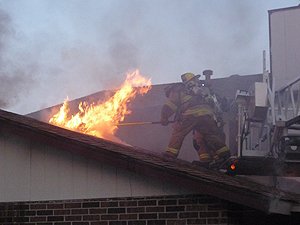Breaking down roofing materials – which are combustible? – April 2015
The ideal roof covering is difficult to ignite. This concept was proven in past centuries during conflagrations, when embers rose on the thermal column, were carried on the wind, fell onto roofs at a distance, and ignited those that were combustible.
Fire ratings for roof coverings are tested by ASTM E-108, UL 790, and National Fire Protection Association (NFPA) 276, Standard Method of Fire Test for Determining the Heat Release Rate of Roofing Assemblies with Combustible Above-Deck Roofing Components, 2011 Edition. These standards classify roof coverings as Class A, Class B, Class C, or “unrated” based on their ability to:
- resist the spread of fire into the attic;
- resist flame spread on the roof covering; and
- resist the generation of burning embers.
Pitched roofs can be finished with a variety of roof coverings. These include:
- Wood shingles (photo 1) are combustible, but can be treated at the mill with fire-retardant chemicals. However, the fire-retardant properties of these chemicals become less effective with weathering, and can be overcome if the shingles are painted or stained.
- Asphalt shingles or roll roofing are made of asphalt with natural fiber or glass fiber felt and are combustible. These are surfaced with mineral grit (like sand) to give them color and to make the surface less ignitable.
- Tile roofs (photo 2) are made of overlapping and interlocking terra cotta or concrete tiles, which are not combustible. Tile roofs provide precarious footing when intact, and become slippery when wet, and impossible when covered with broken pieces of tile that were removed for ventilation.
- Slate roofs (photo 3) are made of overlapping slates: noncombustible natural stone that has been split into thin layers to make roofing materials. These roofs provide precarious footing when intact and become slippery when wet or covered with moss; they become impossible when covered with broken pieces of slate that were removed for ventilation.
- Metal roofs (photo 4) are noncombustible and can often be cut with an ax or power saw at the same time as the wood-roof sheathing to which they are usually attached for vertical ventilation. They provide precarious footing when intact and become slippery when wet. Metal roofing materials are sometimes applied over other types of original roofing materials when they have reached the end of their effective life.
 By: Gregory Havel is a member of the Town of Burlington (WI) Fire Department; retired deputy chief and training officer; and a 30-year veteran of the fire service.
By: Gregory Havel is a member of the Town of Burlington (WI) Fire Department; retired deputy chief and training officer; and a 30-year veteran of the fire service.
Questions?
If you are looking for a new roof or metal roof, then please call
True Green Roofing Solutions or just take a moment and complete
our Request-a-Quote form.
You Have Options!
Don’t wait to schedule your professional estimate!
Call Us Today! (775) 225-1590
